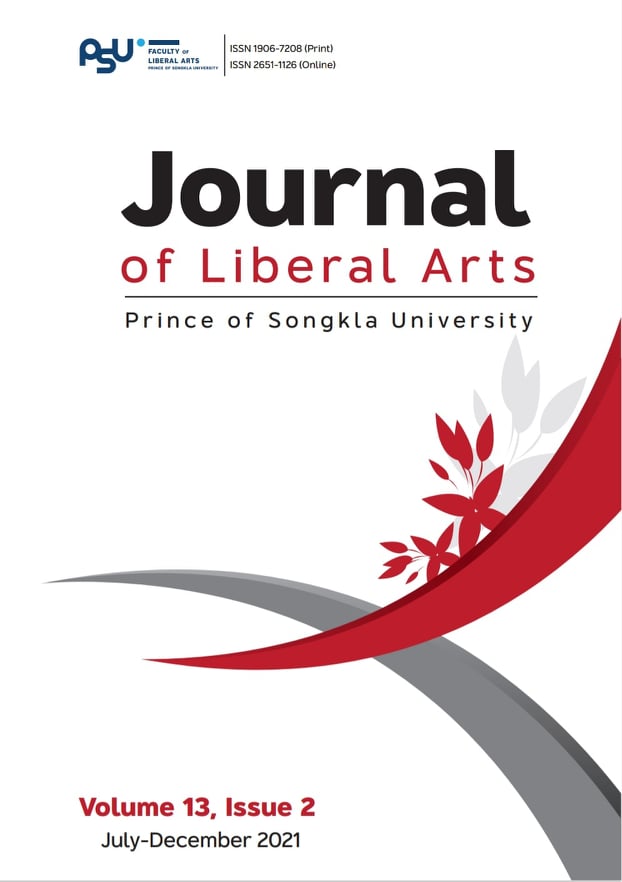การออกเสียงสระภาษาไทยมาตรฐานโดยผู้พูดที่ไม่ใช่เจ้าของภาษา
DOI:
https://doi.org/10.14456/jlapsu.2021.3คำสำคัญ:
การศึกษาทางกลสัทศาสตร์, การเรียนรู้ภาษาที่สอง, สระภาษาไทยมาตรฐานบทคัดย่อ
บทความนี้มีวัตถุประสงค์เพื่อวิเคราะห์ลักษณะทางกลสัทศาสตร์ของเสียงสระภาษาไทยมาตรฐานโดยผู้ที่พูดภาษาเขมร เวียดนาม พม่า และมาเลเซียเป็นภาษาแม่รายการคำที่ใช้ในการทดสอบประกอบไปด้วยสระเดี่ยวเสียงสั้นและสระเดี่ยวเสียงยาว
จำนวน 18 หน่วยเสียงได้แก่ /i e ɛ ɨ ə a u o ɔ ii ee ɛɛ ɨɨ əə aa uu oo ɔɔ/ ผู้บอกภาษาประกอบด้วยผู้พูดที่มีประสบการณ์ภาษาไทยมากจำนวนภาษาละ 3 คน และผู้พูดที่มีประสบการณ์ภาษาไทยน้อยจำนวนภาษาละ 3 คน รวมผู้บอกภาษาทั้งสิ้น 24 คน ดำเนินการบันทึกเสียงผู้บอกภาษาผ่านคอมพิวเตอร์โดยตรง รวมจำนวน
คำทดสอบเพื่อการวิเคราะห์ทางกลสัทศาสตร์ทั้งสิ้น 2,592 คำ จากนั้นวิเคราะห์ค่าทางกลสัทศาสตร์ได้แก่ ค่าความถี่ฟอร์เมินท์ (F1 และ F2) และค่าระยะเวลาของเสียงสระด้วยโปรแกรม พราท ผลการวิจัยพบว่าลักษณะทางกลสัทศาสตร์ภาษาไทยที่ออกเสียงโดยผู้ที่พูดภาษาเขมร เวียดนาม พม่า และมาเลเซียเป็นภาษา
แม่ที่มีประสบการณ์ภาษาไทยมากมีสัทลักษณะที่ดีกว่าในกลุ่มผู้พูดที่มีประสบการณ์ภาษาไทยน้อย นอกจากนี้ ในกลุ่มผู้พูดที่มีประสบการณ์ภาษาไทยน้อยพบว่าเกิดการซ้อนทับกันระหว่างสระสูง สระกลาง และสระต่ำ แสดงให้เห็นว่าเกิดการแปรสูงของ
สระในด้านระดับสูงต่ำของลิ้น ในด้านของความสั้นยาวของเสียงสระพบว่าผู้บอกภาษาเกือบทั้งหมดทั้งในกลุ่มผู้พูดที่มีประสบการณ์ภาษาไทยมากและผู้พูดที่มีประสบการณ์ภาษาไทยน้อยสามารถออกเสียงสระสั้นและสระยาวในอัตราส่วนที่ใกล้เคียงกับผู้พูด
ภาษาไทย อย่างไรก็ตาม ค่าระยะเวลาของเสียงสระในกลุ่มผู้พูดที่มีประสบการณ์ภาษาไทยน้อยจะพบการแปรมากกว่า
References
Abramson, A. S. (1962). The vowels and tones of Standard Thai: Acoustical measurements and experiments. University Microfilms International.
Cebrian, J. (2006). Experience and the use of non-native duration in L2 vowel categorization. Journal of Phonetics, 34(3), 372-387.
Crowley, T. (1997). An introduction to historical linguistics (3rd ed.). Oxford University Press.
Đào, Đ. M., & Nguyễn, A-T. T. (2019). Adult L2 Japanese learners’ production and perception of Vietnamese monophthong vowels. Journal of Second Language Teaching & Research, 7(1), 81-106.
Evans, B. G., & Alshangiti, W. (2018). The perception and production of British English vowels and consonants by Arabic learners of English. Journal of Phonetics, 68, 15-31.
Flege, J. E., & Wayland, R. (2019). The role of input in native Spanish late learners’ production and perception of English phonetic segments. Journal of Second Language Studies, 2(1), 1-44.
Flege, J. E., Bohn, O., & Jang, S. (1997). Effects of experience on non-native speakers’ production and perception of English vowels. Journal of Phonetics, 25, 437-470.
Gandour, J. (1984). Vowel duration in Thai. Crossroads: An Interdisciplinary Journal of Southeast Asian Studies, 2(1), 59-64.
Intajamornrak, C. (2003). The acoustic characteristics of vowels produced by Thai tracheoesophageal and normal speakers and the perception of tracheoesophageal vowels. In L-Thongkum (Ed.), The accent of Thai alaryngeal Thai speakers. (pp. 73-95). Chulalongkorn University Press. [in Thai]
Luangthongkum, T., & Graduate Students. (2011). Thai sounds: An acoustic studies. Chulalongkorn University Press. [in Thai]
Modehira, P. (2005). Correction making among Thais and Americans: A study of cross-cultural and interlanguage pragmatics [Doctoral dissertation, Chulalongkorn University]. Thai thesis database.HTTP://
www.thaithesis.org/detail.php?id=1082548000563 [in Thai]
Phalipat, S. (2009). A comparison of the acoustic characteristics of Hmong, Mien and Mal vowels. In M. Makoto, K. Thepkanjana, W. Aroonmanakun, & M. Endo (Eds.), Proceedings of the Chulalongkorn-Japan Linguistics Symposium. (pp. 183-194). CbLLE Tokyo University of Foreign Studies.
Phiasuphan, K. (2014). A comparison study of Bangkok Thai tones spoken by Thai and Indian speakers: A case study of gender. Journal of Language and Culture, 33(2), 65-89.
Romig, S. (2017). The production and perception of English vowels by native speakers of Brazilian Portuguese living in Victoria, Canada [Master’s thesis, University of Victoria]. https://dspace.library.uvic.ca/handle/1828/8471?show=full
Roengpitya, R. (2001). A study of vowels, diphthongs, and tones in Thai [Doctoral dissertation, University of California, Berkeley]. https://escholarship.org/uc/item/1qq9g93z
Sinthawashewa, T. (2009). The Bangkok Thai tones produced by Japanese speakers: An acoustic and perception study [Master’s thesis, Chulalongkorn University]. http://cuir.car.chula.ac.th/handle/123456789/20001
Suebsor, K. (2019). Thai Tones of Cambodian Speaker Aged 6-12 [Master’s thesis, Thammasat University]. file:///C:/ Users/STD/Downloads/DigitalFile%231_578469.pdf
Teeranon, P. (2016). An acoustic analysis and perceptual study of Thai tones produced by Vietnamese and Khmer speakers. Journal of Language and Culture, 35(1), 81-100. [in Thai]
Thein-Tun, U. (1982). Some acoustic properties of tones in Burmese. In D. Bradley (Ed.), Tonation, Pacific Linguistics Series A 62, Australian National University.
Wong-ampai, N. (2009). The Bangkok Thai tones produced by Pattani Malay children of 6-7 years old: An acoustic and perception study [Master’s thesis, Chulalongkorn University]. https://www.car.chula.ac.th/display7.php?bib=b1863922
Yen-Chen, H. (2017). Second language perception of Mandarin vowels and tones. Language and Speech, 61(1), 135-152.
Yoon, J-H. (2018). The effect of language experience on the production and perception of English vowels by native Korean speakers [Master’s thesis, Ewha Womans University]. https://dspace.ewha.ac.kr/Handle/2015.oak/245783
Downloads
เผยแพร่แล้ว
How to Cite
ฉบับ
บท
License
Copyright (c) 2021 Chommanad Intajamornrak

This work is licensed under a Creative Commons Attribution-NonCommercial-NoDerivatives 4.0 International License.
ลิขสิทธิ์บทความเป็นของผู้เขียน แต่วารสารศิลปศาสตร์ มหาวิทยาลัยสงขลานครินทร์ ขอสงวนสิทธิ์ในการเป็นผู้ตีพิมพ์เผยแพร่เป็นครั้งแรก




